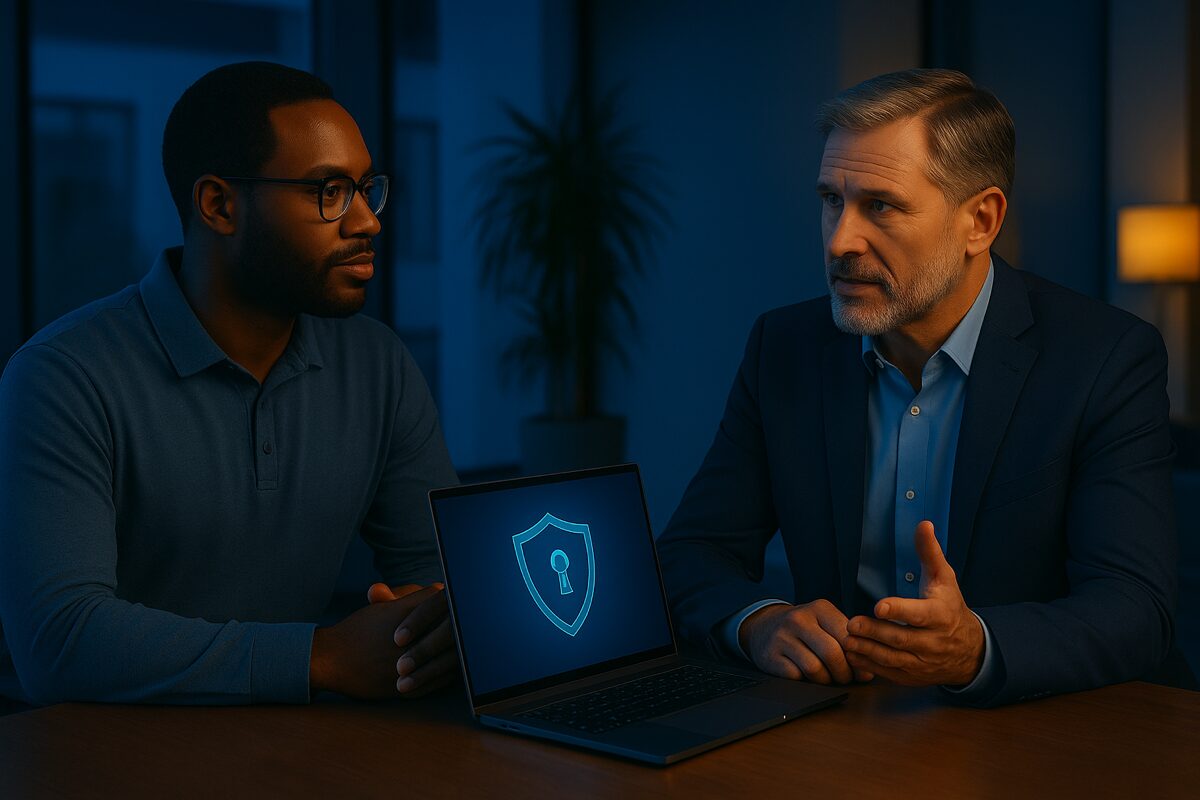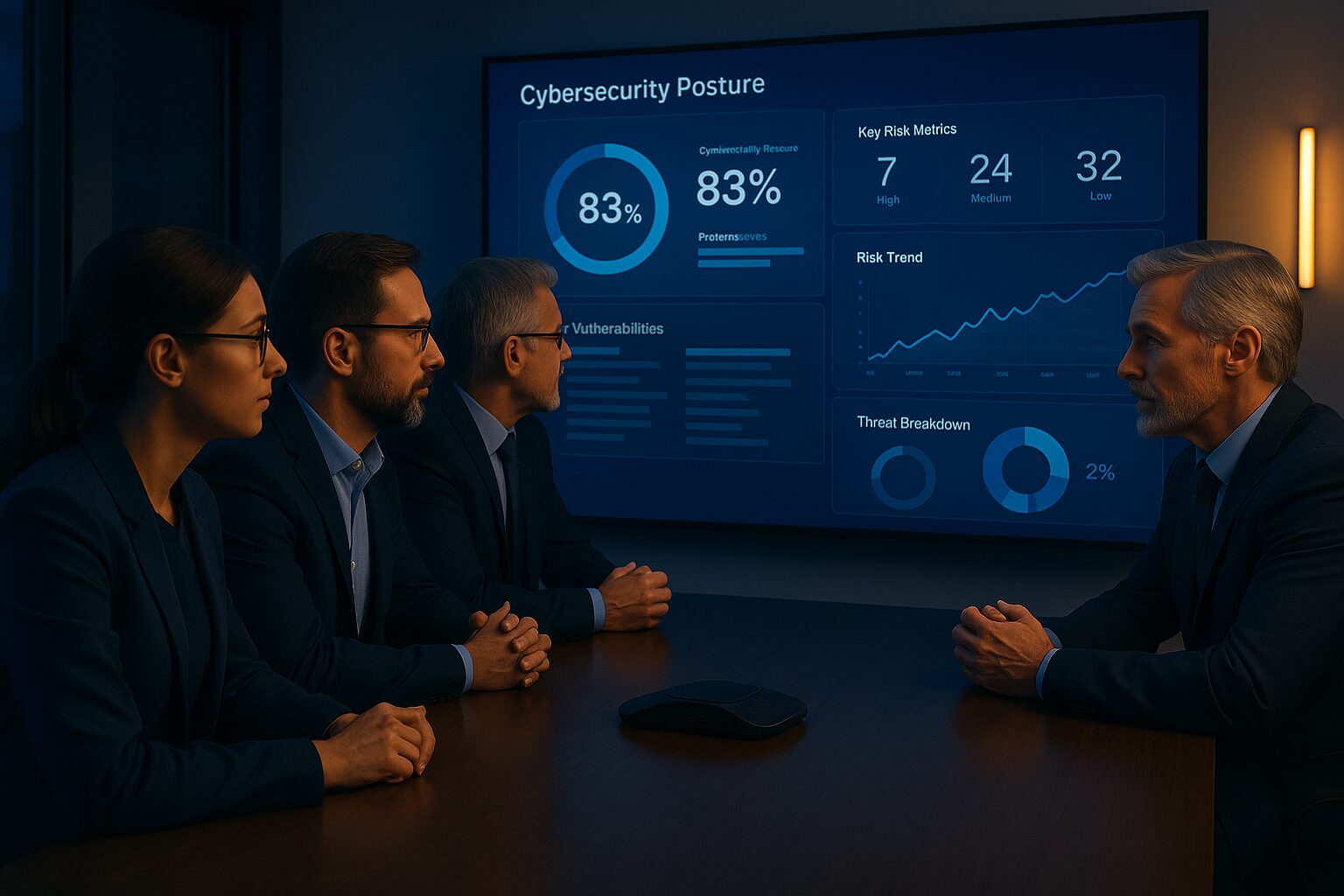Ever wondered if your company could use a seasoned cybersecurity leader, but you’re not ready to hire a full-time executive? Enter the Virtual CISO (vCISO). No, it’s not a superhero or a VR simulation—a vCISO is essentially a “rent-a-CISO”, an experienced security chief you bring in on a flexible basis to protect your organization. This role has emerged as a smart solution for businesses that need high-level security guidance but can’t justify a six-figure in-house CISO salary. Lightly put, a vCISO lets you access a CISO’s expertise without the full-time cost or commitment, which can make any CFO smile.
What is a vCISO (Virtual CISO)?
A virtual Chief Information Security Officer (vCISO) is a senior cybersecurity expert who works with your organization part-time or on-demand – providing the same strategic oversight as an in-house CISO, but in a more flexible arrangement. In practice, this means a vCISO is an outsourced security leader engaged to design and steer your security program remotely, often for multiple clients at once. You get executive-level security guidance (policy development, risk management, compliance strategy, etc.) without having a full-time C-suite employee on payroll. Companies sometimes call this service “CISO-as-a-Service” or fractional CISO, but it refers to the same idea – an experienced security officer for hire.
vCISO vs. In-House CISO: The chief difference comes down to employment and cost. A traditional CISO is a full-time employee embedded in your organization’s day-to-day, whereas a vCISO is an external consultant or team working part-time. Expertise-wise, you shouldn’t miss out—a competent vCISO can deliver nearly all the same strategic outcomes as a full-timer (assessing risks, developing security roadmaps, leading incident preparedness, etc.). But instead of paying a large annual salary (often in the hundreds of thousands of dollars), businesses pay for a vCISO’s time only as needed. In fact, vCISOs typically cost around 30–40% of a full-time CISO. They also tend to hit the ground running with little onboarding – no lengthy training or office politics to navigate. The trade-off? A vCISO isn’t dedicated exclusively to one company, so you give up some on-site presence and immediate availability. For example, an in-house CISO can drop into a crisis at 2 AM without hesitation, whereas a vCISO usually arranges their time in advance. In short: a full-time CISO offers deep daily immersion and instant response, while a vCISO offers efficient, focused expertise on tap. Choosing between them comes down to your organization’s scale, budget, and need for constant security leadership.
Elevate Your Cybersecurity Leadership
Core Responsibilities of a vCISO
A virtual CISO’s day-to-day responsibilities mirror those of any CISO – they’re accountable for your organization’s security posture and strategy. Here are some of the key responsibilities a vCISO typically handles:
- Risk Assessments & Management: Continuously evaluate the organization’s security risks and vulnerabilities and develop strategies to manage or mitigate them. A vCISO will identify where your biggest threats lie (from cyber-attacks to data leaks) and prioritize risk reduction efforts. They translate complex risk scenarios into business terms, helping leadership understand “how much risk do we have and what should we do?”.
- Compliance Oversight: Ensure the company meets relevant regulatory and industry security standards (like HIPAA, PCI-DSS, SOC 2, or GDPR). The vCISO will build and maintain a governance, risk, and compliance (GRC) program, track evolving compliance requirements, and institute policies so that audits and assessments go smoothly. In essence, they keep you on the right side of laws and regulations while avoiding costly penalties.
- Incident Response Planning: Develop and regularly update the organization’s incident response plan – your game plan for cyber crises. A vCISO helps establish clear procedures for detecting, responding to, and recovering from security incidents. This includes running tabletop exercises or drills, so that if a breach or ransomware attack occurs, everyone knows their role. By planning ahead (instead of winging it in panic), a vCISO ensures that your team can respond quickly and effectively to contain damage.
- Security Strategy & Roadmap: Create a long-term cybersecurity roadmap aligned with your business goals. This means the vCISO will lay out a strategy for maturing your security program over time – from choosing the right security frameworks to implementing new controls and technologies. They’ll set priorities (e.g. “improve identity management this quarter” or “achieve ISO 27001 certification by next year”) and then guide your internal IT staff or service providers in executing that plan. The vCISO essentially acts as your security architect, ensuring you have a structured plan to handle threats and protect critical assets as the company grows.
- Executive Reporting & Training: (Bonus duty) vCISOs often present cybersecurity updates to executives or the board, translating tech jargon into business impact. They also help educate employees and IT teams on security best practices. While not on-site daily, a good vCISO is an accessible advisor – coaching your team, advocating for security in business decisions, and even mentoring a less-experienced in-house security lead if you have one. This ensures security becomes ingrained in your company culture, not just an external checkbox.
How vCISO Services Differ from MSSPs or Consultants
It’s easy to confuse a vCISO with other outsourced security services. Two common comparisons are with MSSPs and with one-off security consultants – but a vCISO’s role is distinct from both:
vCISO vs. MSSP
A Managed Security Service Provider (MSSP) (or an MSP for IT) is essentially a “boots on the ground” team handling day-to-day security operations – things like monitoring your network, managing firewalls, patching systems, and responding to alerts . An MSSP focuses on technical and operational tasks to keep you safe and compliant. A vCISO, on the other hand, provides high-level strategic leadership. They’re an independent security advisor who develops strategy, policies, risk management plans, and oversees the big picture of your security program . One way to think of it: an MSSP runs the security tools and watches for intrusions, while a vCISO decides which tools you need, what your policies should be, and how to prioritize security initiatives. The vCISO often will even oversee or coordinate with an MSSP’s work, acting as the client’s advocate to ensure the operational defenses align with the strategy. Another important difference is objectivity – a vCISO provides unbiased oversight. They aren’t there to sell you on a particular product or only report on their own services; instead they audit and guide all aspects of security. This independent perspective is crucial. (It’s a bit like not asking your accountant to audit their own books – having a separate expert for strategy ensures checks and balances in your security program.)
vCISO vs. One-off Consultant
Hiring a security consultant for a one-time project (say, a compliance audit or a penetration test) gives you expertise for that moment, but no ongoing support. A vCISO engagement is typically longer-term and more integrated. Rather than delivering a single report or fix, a vCISO becomes a part of your leadership team (even if virtually), continuously advising and tuning your security program. They attend regular meetings, adjust strategies as your business evolves, and provide continuity. You can certainly engage a vCISO for a short-term project – for example, some companies bring in a vCISO just to build an incident response plan or lead a 3-month compliance initiative. But the real value of a vCISO shines when they operate as an ongoing service: after the initial assessments and recommendations, they stick around to oversee execution and adapt your security roadmap over time. In contrast, a one-off consultant might hand you a list of “to-dos” and walk away, whereas a vCISO is there to ensure those to-dos actually get done and yield results. Think of the vCISO as part-time security leadership, not just a consultant delivering a report.
Strategic IT Guidance for Growth
Flexible vCISO Engagement Models (Retainer vs. Project-Based)
One of the perks of vCISO services is flexibility in how you engage them. You can tailor the arrangement to your needs and budget:
- Monthly Retainer / Ongoing: Most businesses choose to hire a vCISO on a retainer basis, effectively “subscribing” to a certain amount of the vCISO’s time each month or year . For example, you might contract a vCISO for a set number of hours per week or days per quarter, and adjust as needed. This ongoing model ensures the vCISO is continuously involved – conducting regular risk reviews, joining strategy meetings, providing advice whenever security questions arise. It’s like having a CISO on-call. The retainer model is usually structured as a flat monthly fee or annual subscription, which makes costs predictable . Because it’s recurring, the vCISO gets to know your business deeply and becomes a reliable long-term advisor.
- Project-Based / One-Time: In some cases, you might engage a vCISO for a defined short-term project This could be a security assessment, compliance certification prep, incident response plan creation, or any focused initiative. In this mode, the vCISO will perform the specific work and deliver outcomes (e.g. policies, reports, strategies) over a few weeks or months, and the engagement ends when the project is complete . Project-based vCISO services are useful if you have a pressing need but not ongoing budget, or if you want to “try out” vCISO value before committing long-term. Keep in mind, with a one-off project the vCISO’s role is typically advisory – they hand over a plan or solve an immediate problem, but they won’t be around to manage security afterward . Some businesses start with a project (like a comprehensive risk assessment and roadmap) and then extend into a retainer so the vCISO can help execute the plan. The engagement can really be as scalable as you want – from a few hours of consulting to a continuous partnership.
Whether on retainer or project, vCISO agreements are highly customizable. You’ll define the scope: perhaps you need high-level strategy and quarterly check-ins, or maybe hands-on help updating policies and vetting vendors. The “fractional” nature of a vCISO means you pay only for the fraction of time you need. This scalability is a big part of the appeal, especially for growing firms.
Why Growing Companies Adopt vCISO Services Early (Cost vs. Value)
For many small to mid-sized organizations, a vCISO is the first taste of having C-level security leadership – and they’re adopting it early for good reason. Cost is the obvious driver: a full-time CISO’s salary (plus bonuses and benefits) can easily run into the $200k–$300k+ per year range. Young companies often simply cannot afford that. A vCISO, by contrast, offers top-tier expertise at a fraction of the cost. If you’re an early-stage or mid-market business, you get to “pay as you go” for security leadership instead of committing to a massive permanent expense. In lean-budget environments, that’s a game-changer.
But value, not just cost, is the real story. A vCISO can deliver outsized benefits that far exceed what you pay. By identifying critical risks and shoring up defenses early, a vCISO helps prevent disastrous incidents (breaches, ransomware, compliance fines) that could cost millions or even threaten the company’s existence. In that sense, even a part-time vCISO often pays for themselves: one avoided breach or one passed audit can save many times the vCISO’s fee. As security experts like to say, “an ounce of prevention is worth a pound of cure.” A vCISO brings that preventive strategy and oversight. They ensure your security fundamentals are in place – from secure configurations to incident playbooks – so you don’t become an easy target as you grow.
Just as importantly, a vCISO provides immediate access to expertise that most growing companies lack in-house. There’s currently a well-known shortage of skilled security leaders and hiring a veteran CISO is tough even if money is no object. By tapping a vCISO service, a small company can leapfrog ahead in security maturity. You’re essentially renting a professional who’s “seen it all before” at other organizations and can apply those best practices to your environment. For example, startups and SMBs often have no CISO at all (over 60% operate without one) , which leaves a gap in strategy. A vCISO fills that gap early on – providing leadership where none existed. They can set up a solid security program in months, something that might otherwise take years of hard lessons to build internally.
Why adopt early? Because cyber threats don’t wait for you to hire a big security team. Fast-growing companies realize that as they collect sensitive data, expand IT systems, and become more visible, they attract attackers regardless of size. A vCISO helps get ahead of that curve – instilling security practices from the start rather than reacting after an incident. It’s also about credibility and trust: having a vCISO can reassure customers, partners, and investors that you take security seriously even if you’re small. In regulated industries, it might even be a selling point or requirement to demonstrate security leadership. In short, a vCISO lets a growing business punch above its weight in cybersecurity, gaining the kind of executive guidance that only large enterprises typically have. The result is a stronger security posture and peace of mind, without breaking the bank or stalling your growth.
Not Sure Where to Start?
Holistic IT Leadership: vCISO and Fractional CIO Together
While a vCISO focuses on security, many organizations also struggle with broader IT strategy and oversight. That’s where the concept of a Fractional CIO comes in – a similar model of a part-time Chief Information Officer to drive your overall IT roadmap. Security doesn’t exist in a vacuum; it overlaps with IT infrastructure, business continuity, and technology planning. By adopting both vCISO and fractional CIO services, a company can cover all bases for digital leadership. Meriplex, for instance, offers fractional CIO services alongside vCISO to provide this kind of one-two punch in expertise. The fractional CIO concentrates on aligning technology investments with business goals (think digital transformation, systems architecture, vendor management), while the vCISO ensures those initiatives are secure and compliant. Together, they form a holistic IT leadership team for organizations that need guidance in both arenas.
This combined approach is especially powerful for mid-market businesses: you get a virtual “IT Executive Suite” – a CIO and a CISO – on flexible terms. They can collaborate to ensure that security is woven into every IT project from the start, and that your security strategy enables business innovation rather than hinders it. For example, if you’re planning a cloud migration, the fractional CIO will plan the technical execution and resource allocation, while the vCISO will set the cloud security policies and risk parameters so the migration is safe. Both roles bring an objective, third-party perspective, which means you benefit from seasoned decision-makers who aren’t afraid to call out gaps or recommend improvements that internal teams might miss.
In summary, a vCISO wears the “security hat” in your leadership roster – defining how to protect your assets, reduce risk, and respond to incidents – whereas a fractional CIO wears the “technology/business hat” – ensuring your IT systems and strategy fuel growth and efficiency. When you leverage both, it’s like having a complete C-suite for IT without the full-time expense. They complement each other to deliver comprehensive IT governance, risk management, and strategy. Businesses that embrace this model position themselves for smart, secure growth – they have the strategic vision to implement the right technologies and the cyber savvy to keep those initiatives safe.
By demystifying the vCISO role, we see it’s much more than a fancy acronym – it’s a practical way for organizations to get top-tier security leadership on their terms. Whether through a monthly retainer or a one-time engagement, a vCISO can define and drive your security program, bridging the gap between dire cybersecurity needs and limited budgets. And when paired with other fractional executives like a CIO, it ensures your entire IT landscape is under expert guidance. In today’s threat-filled environment, that kind of partnership can be invaluable.



